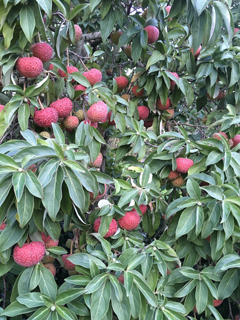 So here we are again, at that cusp between seasons where we don’t know quite what to expect from day to day. After a deliciously clement October (Callum excepted), we are suddenly plunged into icy winds, gloves, and scarves and panic buying of fleece for our tender specimens
So here we are again, at that cusp between seasons where we don’t know quite what to expect from day to day. After a deliciously clement October (Callum excepted), we are suddenly plunged into icy winds, gloves, and scarves and panic buying of fleece for our tender specimens
Although it suddenly feels much colder, the absolute temperatures are not silly low, but the change from double figures centigrade overnight to suddenly close to freezing is a shock to our system, and will be for our plants too.
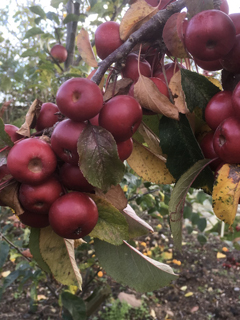
Having finally managed to find some salvia leucantha and salvia corrugata this year to replace one she lost a couple of years ago in a sudden frost (thank you Kelnan Nurseries, Gulval) Helen is taking no chances. Off they went into the greenhouse last night and will not come out at night until or if temperatures pick up. Make sure you keep an eye on your special plants and fleece or move as necessary.
The dry summer has meant it has been a great year for tree fruits, including the apple and pear families, all of which are at their best now, and autumn colour. Just look at the fruits on this cornus capitata – the bough is in dire danger of breaking off if we get a strong south westerly, but beautiful while it lasts. Similarly, crab apples and sorbus have gone great guns this year, and it
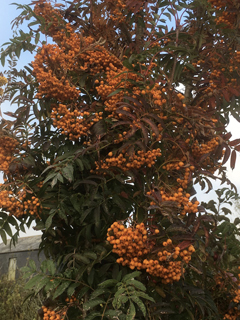
is a reminder now to walk around your gardens, and see what’s missing ready for next year. If you don’t have any autumn colour, don’t think flower, think berry, hips and seed – that’s what autumn interest mostly comprises. Most garden centres and tree suppliers have potted and bare root stock available now, and this is the ideal time for planting.
Having said forget about flowers for autumn colour, how about thinking ahead again and growing some chrysanthemums for next year? Still giving plenty of colour and provided well staked, with keep upright and flowering up until the first frosts. Similarly, dahlias are still burgeoning everywhere. Chrysanthemums and dahlias are really easy to grow – just remember to pinch them out regularly while they are growing so they don’t get too leggy, feed them plenty as they are greedy devils, give them as hot a spot as you can find, and you will be rewarded. They come in every colour and style imaginable so treat yourself to a few plug plants, or scrounge some cuttings and you will be off. Yep, all home grown.
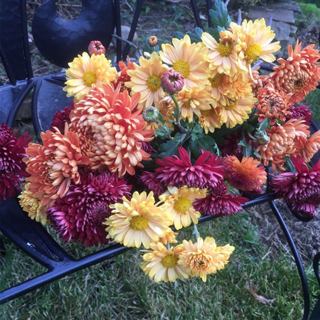
Imagine now we have a dry, warmish day, and you can wrap up for some outside chores. Even with our favourable climate here on the Roseland, it is probably getting a bit late for dividing and replanting herbaceous perennials * (leave those until next spring now) but trees and shrubs are most definitely still a possibility. With both, even though we are entering a wetter time of year, make sure your new plant, or moved plant, if that is what you are doing, is well watered before planting and that the hole you have dug is puddled thoroughly. We recommend mixing a bit of bonemeal into the base of the hole to aid root development, and some well rotted garden compost as an extra feed before topping up with soil.
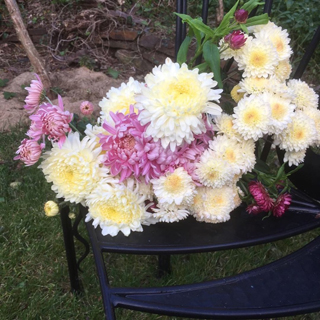 There is also growing evidence that applying mycorrhizal fungi to the rootball of your plant will encourage a good root system and help it become synchronised with the surrounding soil in your garden. Firm your plant in well – if small, with your hands, if large, with your welly-booted foot around it about 6 inches away from the plant’s stem. We can’t ignore that we are in a windy county, so if you are planting a tree, you may want to consider staking it to avoid too much wind rock. Received opinion on this vacillates. At present, it is believed that a bit of top movement helps the roots develop more quickly as an anchor, so stake at 45 degrees a maximum of 1/3 of the way up the trunk. However, there is windy and windy, and only you will know your garden. If it still has a lot to leaves, or is evergreen, it may need more robust staking.
There is also growing evidence that applying mycorrhizal fungi to the rootball of your plant will encourage a good root system and help it become synchronised with the surrounding soil in your garden. Firm your plant in well – if small, with your hands, if large, with your welly-booted foot around it about 6 inches away from the plant’s stem. We can’t ignore that we are in a windy county, so if you are planting a tree, you may want to consider staking it to avoid too much wind rock. Received opinion on this vacillates. At present, it is believed that a bit of top movement helps the roots develop more quickly as an anchor, so stake at 45 degrees a maximum of 1/3 of the way up the trunk. However, there is windy and windy, and only you will know your garden. If it still has a lot to leaves, or is evergreen, it may need more robust staking.
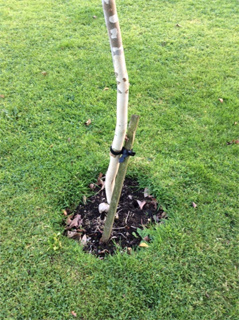 There are also a few shrubs that will benefit from a November haircut to reduce the potential for root rock and potential plant loss in strong winds. These includes the mallow family, particularly lavatera and buddleja . Reduce these by 1/3 to ½ now, and then hard prune after the frosts if you want to contain their size.
There are also a few shrubs that will benefit from a November haircut to reduce the potential for root rock and potential plant loss in strong winds. These includes the mallow family, particularly lavatera and buddleja . Reduce these by 1/3 to ½ now, and then hard prune after the frosts if you want to contain their size.
And there are plenty of seeds you can sow this time of year, in readiness for next, with little work involved. If you are feeling lazy (who, us?) try broadcasting some poppy seed (papaver rhoeas or papaver somniferum), nigella, foxglove. Agitate the soil after you’ve broadcast as these are all seeds that germinate best when the soil is disturbed around them. Running a hoe gently over the broad cast area should do it nicely. Then forget you did it, and you’ll get a nice surprise in late spring/early summer. Assuming you don’t accidentally weed them all out, of course……
 Back in December, when the dreaded C word will be on all our lips. No, not that one!!!
Back in December, when the dreaded C word will be on all our lips. No, not that one!!!
Sarah Daniel and Helen Robins
*Unless you are collecting divisions to swap at the plant sale next May at and in aid of Veryan Village Hall, of course! Take divisions, pot cuttings and dig up seedlings now in readiness, and keep them somewhere sheltered in pots. See the Local News section for more information, and watch this space for confirmation of the date and fine details as the year progresses.
